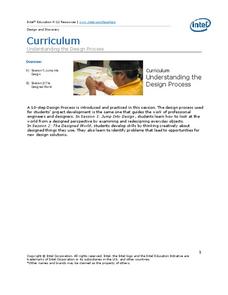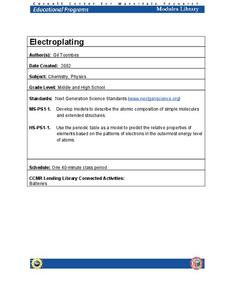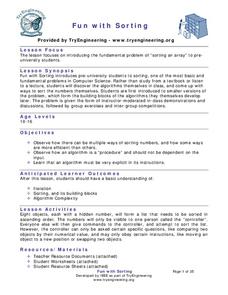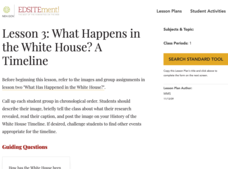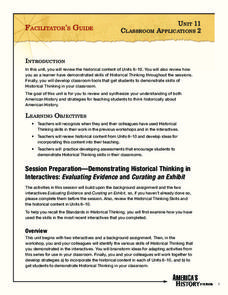Code.org
The Need for Programming Languages
LEGO see if you can recreate my design. Individuals build an arrangement from LEGO blocks and write directions for someone else to follow in order to recreate the arrangement. Pairs then swap directions and try to...
Scholastic
Connecting with Ruby Bridges
When Ruby Bridges entered an all-white school in New Orleans in 1960, she also entered history. Scholars consider what the experience must have been like for the young girl using two books that document her experience as well as a double...
Discovery Education
Clutter Cutter
Challenge young learners to cut the clutter with this fun engineering project. As employees of a home and office supply company, young engineers are asked to develop devices that organize everyday items. After participating in a...
Special Olympics
Walking & Running
Here's a fun collection of activities for helping youngsters develop body awareness, walking and running skills, spatial awareness, fine motor skills, and adaptive physical education skills such as following directions.
EngageNY
More on Modeling Relationships with a Line
How do you create a residual plot? Work as a class and in small groups through the activity in order to learn how to build a residual plot. The activity builds upon previous learning on calculating residuals and serves as a...
Intel
Understanding the Design Process
Can you build a better mousetrap? Broken into two sessions, this plan introduces learners to the design process. The first session has pupils look at the world through a design perspective by redesigning everyday objects. In the second...
Institute of Electrical and Electronics Engineers
Working with Wind Energy
Teams design and build a windmill, under budget, that can lift an object. The groups evaluate and reflect on their own design, then on those produced by other teams. The goal is to determine which design is the most...
Florida Center for Reading Research
Rhyme Pie
Being able to recognize rhyming words is a step closer to understanding the phonemic blends that are necessary for building early reading skills. Little learners use the provided picture cards to make a rhyming pie. They glue rhyming...
Bowland
Pointzero: Confined
Groups plan their escape carefully. Three three-tiered puzzles help a story character escape their situation, each involving integer sequences, transformations, and geometric constructions. The teacher resource includes...
Cornell University
Electroplating
Silver pennies and copper nickels are made possible by applying some chemistry. Learners use electrolysis to coat a penny with zinc sulfate and a nickel with copper sulfate. Their investigation builds an understanding of electroplating...
Ready Houston
Make a Plan. Build a Kit. Stay Informed.
Help prepare your youngsters for an emergency or natural disaster by discussing important topics as where to meet, how to remain in contact, and what belongs in an emergency kit.
TryEngineering
Fun with Sorting
Who knew sorting could be so much fun? Scholars participate in a sorting activity where they develop questions to place a list of numbers in order. They consider how these questions can be used as an algorithm.
Teach Engineering
All Fats Are Not Created Equal
Apply robotics to connect physical properties to chemical properties. Future engineers use robots to determine the melting points of various fats and oils. The robots can do this by measuring the translucency of the fats as they heat up.
Chicago Botanic Garden
What Can Tree Rings Tell Us About Climate?
Tree rings are slightly thicker on the south side of the tree because it receives more sunlight. Part two in a series of five lessons helps learners analyze tree rings to determine the environmental conditions that caused size...
National Endowment for the Humanities
Lesson 3: What Happens in the White House? A Timeline
Working in groups or individually, learners study images of important events that occurred at, or directly affected, the White House, and share their findings of a specific event. They then post the image of their event on a...
Curated OER
Committing to Respect: Lessons for Students to Address Bias
Here's a guide designed to build safe, respectful learning environments, and to build understanding of the value of diversity through lessons packed with activities for specific grade levels.
DiscoverE
Design a Folding Solar Panel
Solar energy is an amazing alternative ... but, not always particularly portable! Challenge young scientists to a folding solar panel build-off with an easy-to-execute activity. Scholars brainstorm around specific design needs, construct...
Overcoming Obstacles
Blowin' in the Wind
Working together isn't as easy as it looks! Small groups of classmates try to keep a balloon in the air using only a straw, their breath, and team communication.
Cornell University
Beam Focusing Using Lenses
Explore optics using an inquiry-based experimental approach! Young scholars use a set of materials to design and build a unit capable of focusing a beam of light. They experiment with different lenses to determine the best approach to...
ARKive
Marvellous Mini-beasts – Design a Species
Here is a creative activity that teaches kids how species evolve different characteristics for survival. The lesson begins as the class discusses and examines the adaptive traits of mini-beasts or insects. Then, in small groups, they...
It's About Time
Photosynthesis, Respiration, and the Carbon Cycle
Provide your class with the opportunity to view our carbon cycle close up. Young scientists research the cycle of oxygen as it completes the tasks of photosynthesis and respiration. They explore the importance of carbon in an ecosystem...
Annenberg Foundation
America's History in the Making: Classroom Applications Two
Reading between the lines helps discover important information! The 11th lesson of a 22-part series on American history has scholars use historical thinking skills to uncover the deeper meaning behind the words on a page. Using backward...
Shakespeare Globe Trust
Fact Sheet: The Third Globe
Hopefully the third time's a charm when it comes to rebuilding London's Globe Theatre! With an informational text, readers learn about the reconstruction of the theatre in the 1990s. They also discover how modern health and safety...
Cornell University
Predicting Chemical Reactions
Prove the Law of Conservation of Mass through a lab investigation. A well-designed lesson asks groups to combine materials and monitor indicators for chemical reactions. Measuring the mass of the reactants and products allows individuals...





